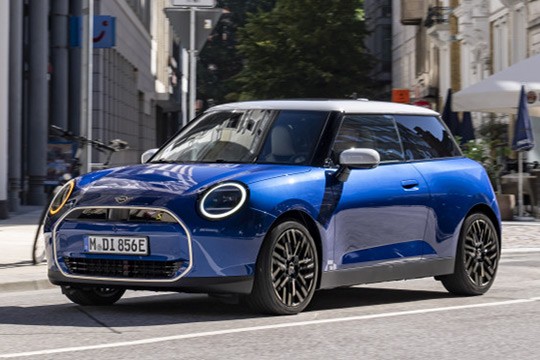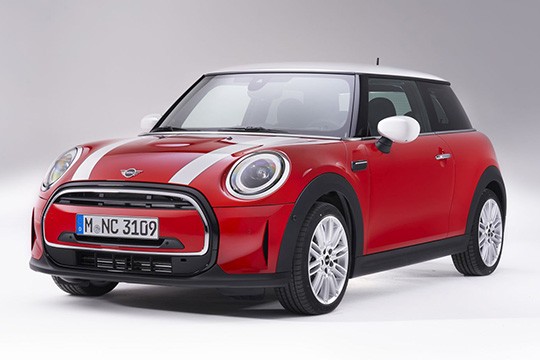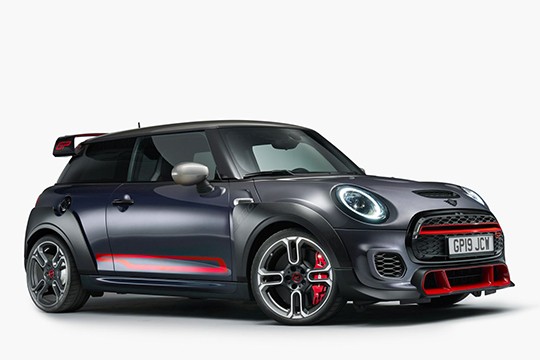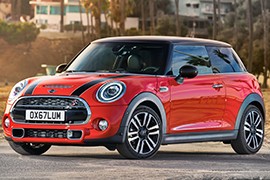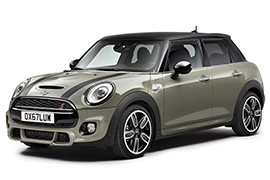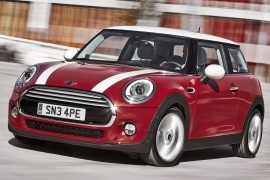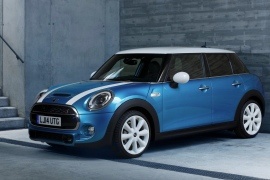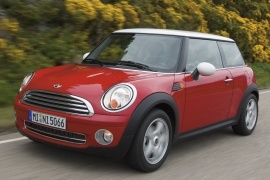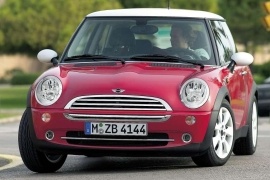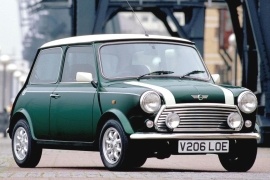MINI Hatch Models/Series Timeline, Specifications & Photos
First production year: 1997
Engines: Electric, Gasoline, Diesel
Body style: Hatchback
MINI introduced the fourth generation of its three-door hatchback model in September 2023 and put more emphasis on the electrification of this model, offering it with a punchier version named SE.
The British car evolved constantly after it was purchased by BMW and rushed through generations with more and more updates. Its first electric version was based on the ICE-powered platform, but that was changed in 2023. Then, the automaker created an electric platform for the model but didn’t ditch versions powered by internal combustion engines. Still, the SE came to prove to customers that they could still enjoy a small-sized vehicle, especially when it was equipped with a punchy motor. Furthermore, starting with the 2023 model year, the automaker finally decided to name the hatchback MINI Cooper, honoring the car’s legacy.
From the outside, it was a mix of retro-styling and modern technology. At the front, the LEDs that encircled the headlights were used for turn signals and daytime running lights as well. The headlamps also featured LED blocks and flanked the octagonal front panel that resembled a grille. From its profile, the vehicle’s proportions and the characteristic design elements left no mistakes about the brand or the model. Still, the Cooper SE was exclusively available with a three-door bodywork, while its gasoline-powered sibling was still offered with a five-door variant. MINI created the Cooper SE with flush door handles and no overfenders, thus creating a flowing design. At the back, the slightly tilted forward tailgate was adorned at its top by a roof spoiler. Strangely, the rear taillights featured a triangular shape and sported a Matrix LED pattern that resembled the Union Jack.
Inside, the cabin featured a minimalist design inspired by the original 1959 Mini created by Sir Alec Issigonis. Fronting the driver was a three-spoke steering wheel and the optional head-up display. The big and round, 9.5-inch touchscreen mounted atop the center stack featured a customizable background. As an option, the car could be equipped with a Harman Kardon sound system. All the materials were vegan and environmentally friendly. The bolstered front seats were fitted as standard with a mix of fabric and leatherette with an option for full artificial leather. In the back, the car offered enough room for two adults thanks to the vehicle’s long wheelbase for its size. The trunk offered 200 liters (7 cu-ft.) of space and was enough for a daily vehicle.
The automaker installed a 218 hp (160 kW) motor in the MINI Cooper SE that powered the front wheels. Its performance was quite surprising, offering a 0 to 100 kph (0-62 mph) acceleration time of just 6.7 seconds. MINI said that the car could get a 250-mile (402 km) range with a fully charged battery pack that could hold 54.2 kWh.
In 2000, the MINI brand raised from its ashes, helped by its new partner, BMW, and introduced a new model range.
In 2021, MINI already reached its fourth generation and came full-power in a few versions: three doors, five doors, and the convertible. That refresh was mandatory; hence there were new emission regulations in Europe, and the carmaker tried to stay on top of its game and offer the best products in the segment.
It is hard for a designer to make a nearly identical, yet different, vehicle. The MINI's shape was everyone's vanilla, and it had to stay that way. For the 2021 model, a piano-black surrounding emphasized the grille area, while a fat horizontal bar sported the license plate. In the rear, the Union Jack appeared on the taillights. The MINI sported a unique multi-tone roof.
Inside, MINI received a big display instead of its regular dials in the instrument cluster. The touch-screen on the center stack was already offered as an option from the third generation. Its front sport-bucket seats featured high-bolstering. The carmaker kept the same design for the steering wheel with three thick spokes and added buttons on the horizontal ones. Like on its predecessors, to access the rear seats, the front ones had to be tilted and slid forward.
Under the hood, MINI offered the three-door version with a choice of three engines, apart from the electric version. The carmaker completely removed the diesel versions from the lineup.
60 years after the debut of the classic Mini, Mini John Cooper Works GP unveiled a perfect combination of power and agility. With the most powerful engine fitted in a Mini under the hood, the JCW GP is the fastest model the Brits ever made for road use.
With a 225 kW/306 hp 4-cylinder turbocharged engine, the new Mini John Cooper Works GP can accelerate from zero to 100 kph in just 5.2 seconds, making this car exceptional at leaving higher-category sports cars behind on intermediate sprints. To give you an idea of how powerful the car is, it is suffice to say that it only took eight minutes to go around Nurburgring.
The top speed of 265 km/hour and the combined fuel consumption of 7.3 liters/100 km, along with the 8-speed Steptronic sports transmission makes this car a little racing monster. The rigid body structure, the engine, the roof spoiler with double wing contour and the precisely geared suspension lowered by 10 mm as compared to the Mini John Cooper Works, summons the competitiveness spirit of every driver by unmistakably painting the successful image of John Cooper himself winning the Monte Carlo Rally.
The outstanding characteristics of JCW GP pave the way for an unmatched experience. The Mini John Cooper Works GP model is manufactured in a limited edition of 3,000 units, each taking the driving experience in a premium small car to a whole new level.
Nobody buys a MINI for its practicality. The MINI is a statement for fashion, for design, and, depending on the version, for a sporty character.
Since it was acquired by BMW in 1994 along with the Rover Group, the Mini launched three generations of the MINI hatchback. And it kept growing ever since in size and engines. The third generation offered a wide variety of options and, somehow, it lost its initial sporty spirit. But it gained its place in the premium small-car segment.
The 2018 MINI was not quite a MINI anymore. It grew so much that it could be called a Maxi-MINI. But still, it has the same character on design, with its specific old-school grille and round headlights. It had some nice details and that continued inside the car, as well.
The dashboard is unique on the market, with a big round display for the infotainment system in the middle of the center console and few more dials in front of the driver. There are some other items inside that are specific to the MINI. For instance, the start button was placed on the center console, under the big round infotainment unit and it looked like it belonged into an aircraft.
For the engine choices, the 2018 MINI was available with diesel and gasoline engines, with three or four cylinders, and all of them were turbocharged.
MINI was the first small-class premium vehicle and it kept that advantage for many years until other car-manufacturers entered the competition. But the British brand succeeded to keep its sparkling image on the market.
MINI grew up and so its customers. This is why it needed a bigger version. That being said, the company engineers stretched a 3-door MINI, shortened the front doors and installed a new pair in the back. The outside look is almost the same, with a short front and rear overhangs and an almost vertical front fascia.
The 2018 MINI 5-doors had the same round headlights that made the car so popular around the world. The grille was kept small. It didn't need a larger air intake since most of the engines were small. For the sportier versions such as Cooper S and John Cooper Works, the engineers installed an air scoop on the hood.
Inside the vehicle, the driver had the same old-fashion look of the dashboard and instrument cluster, but those were updated with TFT screens and a touch-screen display in the middle of the central console. The space in the rear was large enough for three skinny passengers. The trunk was big enough for some shopping, but for a shopping spree, it was necessary to fold the rear seats.
One of the most important features of the MINI was the rear independent suspension that made the car very comfortable for its class, where most of the vehicles had a semi-rigid type. An 8-speed automatic transmission was available for selected models, while the standard gearbox was a 6-speed manual.
BMW's modern-era MINI turned out to be a much more sophisticated thing. Despite having grown a bit in dimensions, the 2014 MINI Hatch carries forward its predecessor's aspiration to remain the leading original of the premium small car segment, providing significant advancements in all areas, including driving fun, quality, and individual flair.
Considering that the Countryman was the first MINI to have five doors, with the introduction of the F55-series model in 2014, the BMW brand talked of this design as being 'the first ever 5-door MINI Hatch,' and that actually brought to this MINI a lot of enjoyability and a serious competitor to its rivals.
For fans, the worst mistake any MINI can make is lose its 'MINI-ness.'The new MINI is now 98 mm longer, 44 mm wider, and 7 mm higher than its predecessor. The wheelbase has been extended by 28 mm, all allowing for improved cornering and ride comfort and increased interior room.
The extra rear doors are pretty small, so squeezing in and out can be tricky. The boot, instead, has plenty of space for its class and for a car of its size. The opening degree gives good practicality when you want to put something in the back.
There is not too much to say about the interior. It is quitesimilar to other MINI models of the same production year, and also not very different from the previous generation. This is quite a bit unpleasant because, from one generation to another, you would expect some significant upgrades and modifications.
It has aggressive-styled seats covered in Dinamica/fabric, badged door sills, perforated leather-wrapped steering wheel, aluminum pedals, and paddle shifters. Performance upgrades include a new suspension and electromechanical power steering, DSC, DTC, electronically lockable differential, and damper adjustment.
What do we get under the bonnet? It's a front-wheel drive front-engined with 134 BHP; the turbocharged 1.5-liter 12v inline 3 petrol engine (BMW B38A15) accelerates this Cooper 5-Door to 62 mph in 8.2 seconds and on to a maximum speed of 129 mph (208 kph).
With a curb weight of 1,220 kg (2,690 pounds), it achieves 60.1 mpg (4 liters per 100 km) on average and can travel 528 miles (850 km) before requiring a refill of its 40-liter (11-gallon) fuel tank. It comes with a choice of either a 6-speed manual gearbox or a 6-speed automatic gearbox. For Europe, it is also available in a 2.0-liter diesel engine, which has a better fuel economy.
Overall, the F55 Mini is British build quality, and this third-generation Hatch design's classy and playful. Best of all, perhaps, the extra length of this variant has done nothing to dilute its fun factor. We consider it a great choice for a town car that fits well for a young person or a mother taking her child to school.
MINI Hatch (F55) Cooper 1.5L 6AT FWD (136 HP)
MINI Hatch (F55) Cooper 1.5L 6MT FWD (136 HP)
MINI Hatch (F55) Cooper S 2.0L 6AT FWD (192 HP)
MINI Hatch (F55) Cooper S 2.0L 6MT (192 HP)
MINI Hatch (F55) John Cooper Works 2.0L 6AT FWD (231 HP)
MINI Hatch (F55) John Cooper Works 2.0L 6MT FWD (231 HP)
hen BMW took MINI and transformed it into a fashionable, premium little car, the world was excited. But when the owners needed those two seats in the back, it wasn't so nice anymore. That's why MINI came up with the solution of the 5-doors hatchback. Maybe it is not that appealing anymore, but for sure it is far more practical. The kids won't have to squeeze between the front seat and the B-pillar to take their seats in the back. Also, there is no problem to lift your friends when going out. But the rear seats legroom is not so generous due to the 2567 mm (101.1 in) wheelbase.
The trunk is not big. It is smaller than the competition, but nobody should choose its city hatchback for a big trunk. It is enough to accommodate the weekly shops. In case of emergency, the seatbacks of the rear seats can be folded down in a split 1/3-2/3 system.
The interior features are up to a premium car. Navigation, different driving settings, great sound system and finishes over the other vehicles from its segment.
Under the hood, MINI installed 5 internal combustion engines and one electric version. There are three gasoline units and two turbodiesels. The top of the range is the Cooper JCW (John Cooper Works) with 306 hp. The base is still a small, 1.2-liter unit offering just 75 hp. The available transmissions are with a 6-speed manual, 6 or 8 speed automatic or a 7-speed dual-clutch, depending on the engine.
After BMW took-over the Mini brand, it relaunched the famous British name on the market in 2000 with a fresh vehicle, but with a styling that resembled the former Monte-Carlo Rally champion.
The second generation of the Mini hatch was released in 2006 and it didn't need too much introduction since it looked almost the same as its predecessor. Underneath the similar design, it was a completely new car.
The new headlights incorporated the turn signals. They looked similar to those from the 2000 model year, but they were not the same. The short hood and the vertical A-pillars were characteristic of the Mini hatchback. The black pillars created the impression of a floating roof.
Inside, the Mini featured the same layout as its predecessor, with a big speedometer on the center stack. Behind the steering wheel, there was a big tachometer with an LCD on the bottom for the on-board computer, which moved up and down with the steering column, which was adjustable for height and reach. In the front, there was a good amount of space for the passengers, but in the back, the legroom was very tight. A 50:50 split backseat extended the trunk.
Under the hood, the 2006 Mini featured a new generation of engines developed together by BMW and Peugeot. They replaced the older 1.6-liter units provided by Chrysler. Depending on the engine version, they were mated to a standard 5- or 6-speed manual. An automatic transmission was on the options list.
When BMW sold the Rover brand, it kept the Mini to pursue its plans on expanding on the rising market of small-segment premium vehicles.
The first model introduced by the British brand after the German involvement was the MINI hatchback in late 2000. Its retro-design styling left no confusion regarding its origins, and BMW sold over one million units of it in just six years of production time.
The rounded shapes of the new R50, MINI were an instant success on the market. It was more of a fashion item than a transportation device. Even if it costed more than most of the small-segment vehicles available, the premium customers were happy. Depending on the trim level, the car sported a chromed or a body-colored grille at the front. For the supercharged (Cooper S) version, the carmaker installed an air-intake on the hood.
Inside, the car was different than anything else on the market. With switches inspired by WWII airplanes and a big, round dial placed on top of the center stack, the MINI was different. It offered a low seating position and a retro-style design for the gear-stick. In the back, it provided room for two adults on the split-folding bench.
Under the hood, MINI installed a choice of three engines. The carmaker installed a 1.4-liter unit for specific markets, while the rest of the world received a 1.6-liter version. The Cooper S model received a supercharged 1.6-liter four-pot powerplant. The diesel version came later on, and MINI carried it over from Toyota. One key element for the MINI was the independent suspension in all corners, a unique feature on the small segment.
It was the last stint for the original Mini designed by Sir Alec Issigonis, and despite its age, it was still a fun car and loved by their owners, as long as they were not tall.
When it designed the Mini back in the early '60s, nobody could tell that the tiny car would have such a success. From time to time, the British carmaker, which traded hands several times, included few updates until 1997 when the last series saw the broad of light.
On the outside, it was almost the same MINI as before. It showed the same very short front area with a straight-up fascia that sported a pair of round headlights and a chromed grille. A set of additional fog lights (or two sets) was on the options list, especially for the Cooper S version. From its sides, the enlarged wheel-arches featured plastic molds to cover the wider 13" light-alloy wheels. Despite the new regulations, the carmakers didn't fit plastic bumpers and still relied on the same metallic, chrome-plated ones.
Inside, it was room for four adults, by the '60s standards. But it was less roomy than someone would think. Its low-mounted seats made it possible even for six-footers (1.82 m) occupants to fit inside, at least for short distances. From 1997, the carmaker added steel beams inside the doors to enhance protection. For the same reason, MINI introduced a driver airbag in the steering wheel.
The carmaker installed a 1.3-liter engine with two injection ports that led to 63 hp under the hood. It was paired to a four-speed manual gearbox, which sent the power to the front wheels.
